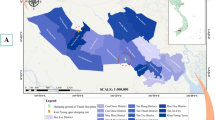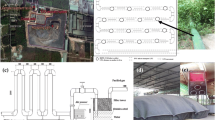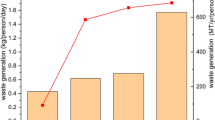Abstract
High Canadian waste disposal rates necessitate landfill gas monitoring and accurate forecasting. CO2 estimates in LandGEM version 3.02 currently rest on the assumptions that CO2 is a function of CH4, where the two gases make up nearly 100% of landfill gas content, leading to overestimated CO2 collection estimates. A total of 25 cases (five formulas, five approaches) compared annual CO2 collection at four western Canadian landfills. Despite common use in literature, the 1:1 ratio of CH4 to CO2 was not recommended to forecast landfill gas collection in cold climates. The existing modelling approach significantly overestimated CO2 production in three of four sites, resulting in the highest residual sum of squares. Optimization resulted in the most accurate results for all formulas and approaches, which had the greatest reduction in residual sums of squares (RSS) over the default approach (60.1 to 97.7%). The 1.4 Ratio approach for L o:L o-CO2 yielded the second most accurate results for CO2 flow (mean RSS reduction of 50.2% for all sites and subsection models). The annual k-modified LandGEM calculated k’s via two empirical formulas (based on precipitation) and yielded the lowest accuracy in 12 of 20 approaches. Unlike other studies, strong relationships between optimized annual k’s and precipitation were not observed.






Similar content being viewed by others
References
Abushammala MFM, Basri NEA, Basri H, Kadhum AAH, El-Shafie AH (2012) Methane and carbon dioxide emissions from Sungai Sedu open dumping during wet season in Malaysia. Ecol Eng 49:254–263
Aguilar-Virgen Q, Taboada-Gonzalez P, Ojeda-Benitez S, Cruz-Sotelo S (2014) Power generation with biogas from municipal solid waste: prediction of gas generation with in situ parameters. Renew Sust Energ Rev 30:412–419. doi:10.1016/j.rser.2013.10.014
Ahmed SI, Johari A, Hashim H, Lim JS, Jusoh M, Mat R, Alkali H (2015) Economic and environmental evaluation of landfill gas utilisation: a multi-period optimisation approach for low carbon regimes. International Biodeterioration & Biodegradation 102:191–201. doi:10.1016/j.ibiod.2015.04.008
Alexander A, Burklin C, Singleton A (2005) Landfill gas emissions model (LandGEM) version 3.02 user’s guide. EPA-600/R-05/047. U.S. EPA, Washington, D.C.
Amini HR, Reinhart DR, Mackie KR (2012) Determination of first-order landfill gas modelling parameters and uncertainties. Waste Manag 32:305–316. doi:10.1016/j.wasman.2011.09.021
Amini HR, Reinhart DR, Niskanen A (2013) Comparison of first-order-decay modeled and actual field measured municipal solid waste landfill methane data. Waste Manag 33:2720–2728. doi:10.1016/j.wasman.2013.07.025
Barlaz MA, Ham RK, Schaefer DM (1989a) Mass-balance analysis of anaerobically decomposed refuse. J Environ Eng 115(6):1088–1102
Barlaz MA, Schaefer DM, Ham RK (1989b) Bacterial population development and chemical characteristics of refuse decomposition in a simulated sanitary landfill. Appl Environ Microbiol 55(1):55–65
Barlaz MA, Chanton JP, Green RB (2009) Controls on landfill gas collection efficiency: instantaneous and lifetime performance. J Air Waste Manag Assoc 59:1399–1404. doi:10.3155/1047-3289.59.12.1399
Bruce N, Wang Y, Ng KTW (2015) A province-wide comparison of non-hazardous waste generation and recycling rates. In: Proceedings, 2015 CSCE annual conference, Regina, Canada, May 27–30. Organized by Canadian Society for Civil Engineering
Bruce N, Asha AZ, Ng KTW (2016) Analysis of solid waste management systems in Alberta and British Columbia using provincial comparison. Can J Civ Eng 43:351–360. doi:10.1139/cjce-2015-0414
Calabro PS, Orsi S, Gentili E, Carlo M (2011) Modelling of biogas extraction at an Italian landfill accepting mechanically and biologically treated municipal solid waste. Waste Manag Res 29(12):1277–1285. doi:10.1177/0734242X11417487
Canart C, McMartin D (2009) Solid waste audit of Regina Fleet Street Landfill. University of Regina, Regina
Chalvatzaki E, Lazaridis M (2010) Estimation of greenhouse gas emissions from landfills: application to the Akrotiri landfill site (Chania, Greece). Global NEST Journal 12(1):108–116
Comcor Environmental Ltd. (2010) Design basis memorandum: landfill gas collection system and compressor/flare station project. Saskatoon, Saskatchewan, Canada
Conestoga-Rovers & Associates (2006) Site plan and LFG collection system layout. Regina, Saskatchewan, Canada
Environment Canada (2014) National Inventory Report 1990–2012: greenhouse gas sources and sinks in Canada. Environment Canada, Gatineau
Fillipone MA, Robins C, Wilson K, Tradewell K, Lacey D (2012) Hartland landfill environmental program: 2011–12 annual report. Capital Regional District. Victoria, B.C., Canada
Garg A, Achari G, Joshi RC (2006) A model to estimate the methane generation rate constant in sanitary landfills using fuzzy synthetic evaluation. Waste Management and Research 24:363–375. doi:10.1177/0734242X06065189
Gevantman LH (n.d.) Solubility of selected gases in water. Retrieved September 1, 2016 from http://sites.chem.colostate.edu/diverdi/all_courses/CRC%20reference%20data/solubility%20of%20gases%20in%20water.pdf
Golder Associates (2015) 2014 Annual report: Cache Creek landfill. Submitted to Wastech Services Ltd. Cache Creek, B.C., Canada
Goswami S, Maheshwari M, Nema AK (2011) Mineral sequestration of CO2 generated in landfills. Proceedings of the 3rd international conference on environmental management, engineering, planning, and economics & SECOTOX conference, June 19–24, Skiathos, Greece. 721–730
Guter KJ, Nuerenberg RL (1987) Landfill gas recovery in Michigan. Waste Management and Research 5:465–472
Hettiarachchi H, Hettiaratchi JPA, Hunte CA, Meegoda JN (2013) Operation of a landfill bioreactor in a cold climate: early results and lessons learned. Journal of Hazardous, Toxic, and Radioactive Waste 17:307–316. doi:10.1061/(ASCE)HZ.2153-5515.0000159
IPCC (1996) IPCC Good practice guidance and uncertainty management in national greenhouse gas inventories. Available at: http://www.ipcc-nggip.iges.or.jp/public/gp/english/5_Waste.pdf. Accessed 5 Apr 2016
Jeong S, Nam A, Yi S-M, Kim JY (2015) Field assessment of semi-aerobic condition and the methane correction factor for the semi-aerobic landfills provided by IPCC guidelines. Waste Manag 36:197–203. doi:10.1016/j.wasman.2014.10.020
Karanjekar RV, Bhatt A, Altouqui S, Jangikhatoonabad DV, Sattler ML, Chen V (2015) Estimating methane emissions from landfills based on rainfall, ambient temperature, and waste composition: the CLEEN model. Waste Manag 46:389–398. doi:10.1016/j.wasman.2015.07.030
Kumar A, Sharma MP (2014) Estimation of GHG emission and energy recovery potential from MSW landfill sites. Sustainable Energy Technologies and Assessments 5:50–61. doi:10.1016/j.seta.2013.11.004
Lee C-E, Hwang C-H (2007) An experimental study on the flame stability of LFG and LFG-mixed fuels. Fuel 86:649–655. doi:10.1016/j.fuel.2006.08.033
Machado SL, Carvalho MF, Gourc J-P, Vilar OM, do Nascimento JCF (2009) Methane generation in tropical landfills: Simplified methods and field results. Waste Manag 29(1):153–161. doi:10.1016/j.wasman.2008.02.017
Maciel FJ, Juca JFT (2011) Evaluation of landfill gas production and emissions in a MSW large-scale experimental cell in Brazil. Waste Manag 31:966–977. doi:10.1016/j.wasman.2011.01.030
Marroni V, Dall’Ara A, Ferri F, Lanzarini S (2010) Innovative remediation and monitoring system inside an area used for paper sludge recovery. Environmental Quality 5:43–52. doi:10.6092/issn.2281-4485/3803
McDougall JR, Pyrah IC (1999). Moisture effects in a biodegradation model for waste refuse. In: As presented at the 1999 Sardinia conference in Italy. Civic Engineering, Napier University
Myhre G, Shindell D, Bréon F-M, Collins W, Fuglestvedt J, Huang J, Koch D, Lamarque J-F, Lee D, Mendoza B, Nakajima T, Robock A, Stephens G, Takemura T, Zhang H (2013) Anthropogenic and natural radiative forcing. In: Climate Change 2013: The Physical Science Basis. Contribution of Working Group I to the Fifth Assessment Report of the Intergovernmental Panel on Climate Change [Stocker, T.F., Qin, D., Plattner, G.-K., Tignor, M., Allen, S.K., Boschung, J., Nauels, A., Xia, Y., Bex, V., and Midgley, P.M. (eds.)]. Cambridge University Press, Cambridge, United Kingdom and New York, NY, USA
Rezaee R, Nasseri S, Mahvi AH, Jafari A, Mazloomi S, Gavami A, Yaghmaeian K (2014) Estimation of gas emission released from a municipal solid waste landfill site through a modelling approach: a case study, Sanandaj, Iran. Journal of Advances in Environmental Health Research 2(1):13–21
Richter A, Bruce N, Ng KTW, Chowdhury A, Vu HL (2017) Comparison between Canadian and Nov a Scotian waste management and diversion models – A Canadian Case Study. Sustainable Cities and Society 30:139–149. doi:10.1016/j.scs.2017.01.013
Sadek S, Ghanimeh S, El-Fadel M (2007) Predicted performance of clay-barrier landfill covers in arid and semi-arid environments. Waste Manag 27:275–583. doi:10.1016/j.wasman.2006.06.008
Saquing JM, Chanton JP, Yazdani R, Barlaz MA, Scheutz C, Blake DR, Imhoff PT (2014) Assessing methods to estimate emissions of non-methane organic compounds from landfills. Waste Manag 34:2260–2270. doi:10.1016/j.wasman.2014.07.007
Spokas K, Bogner J, Chanton J, Morcet M, Aran C, Graff C, Moreau-le-Golvan Y, Bureau N, Hebe I (2006) Methane mass balance at three landfill sites: what is the efficiency of capture by gas collection systems? Waste Manag 26:516–525. doi:10.1016/j.wasman.2005.07.021
Tchobanoglous G, Kreith F (2002) Handbook of solid waste management, 2nd edn. McGraw-Hill, New York, p 14.14
Thompson S, Tanapat S (2005) Modelling waste management options for greenhouse gas reduction. Journal of Environmental Informatics 6(1):16–24. doi:10.3808/jei.200500051
Thompson S, Sawyer J, Bonam R, Valdivia JE (2009) Building a better methane generation model: validating models with methane recovery rates from 35 Canadian landfills. Waste Manag 29:2085–2091. doi:10.1016/j.wasman.2009.02.004
Tolaymat TM, Green RB, Hater GR, Barlaz MA, Black P, Bronson D, Powell J (2010) Evaluation of landfill gas decay constant for municipal solid waste landfills operated as bioreactors. Journal of Air and Waste Management Association 60(1):91–97. doi:10.3155/1047-3289.60.1.91
Wang Y, Ng KTW, Asha A (2016) Non-hazardous waste generation characteristics and recycling practices in Saskatchewan and Manitoba, Canada. Journal of Material Cycles and Waste Management 18(4):715–724. doi:10.1007/s10163-015-0373-z
World Bank Group (2016) Population density (people per sq. km of land area). Retrieved September 16, 2016, from http://data.worldbank.org/indicator/EN.POP.DNST?name_desc=false
Worrell WA, Vesilind PA (2012) Solid waste engineering: SI edition, 2nd edn. Cengage Learning, Stamford, p 316
Acknowledgements
The research reported in this paper was supported by a grant (RGPIN-385815) from the Natural Sciences and Engineering Research Council of Canada. The authors are grateful for their support. Special acknowledgment goes to the cities’ landfill teams, who supported the data collection. The views expressed herein are those of the writers and not necessarily those of our research and funding partners.
Author information
Authors and Affiliations
Corresponding author
Ethics declarations
Conflict of interest
The authors declare that they have no conflict of interest.
Additional information
Responsible editor: Marcus Schulz
Rights and permissions
About this article
Cite this article
Bruce, N., Ng, K.T.W. & Richter, A. Alternative carbon dioxide modelling approaches accounting for high residual gases in LandGEM. Environ Sci Pollut Res 24, 14322–14336 (2017). https://doi.org/10.1007/s11356-017-8990-9
Received:
Accepted:
Published:
Issue Date:
DOI: https://doi.org/10.1007/s11356-017-8990-9




